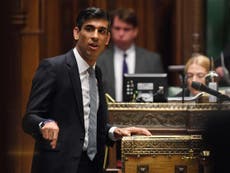Don’t be misled by today's unemployment figures – a hurricane of job losses is coming
We can reasonably expect the number of people in the UK out of work to rise to between three and four million – a far graver toll, at the upper end, than even the mass unemployment of the 1980s.

When we look at official statistics on the economy’s performance we’re always looking through a rear view mirror. It takes time to collect and process the mass survey data on which most of the figures are based. By the time they are published the economy will have generally moved on.
But when it comes to official jobs data in the midst of this pandemic we’re not only looking through a rear view mirror – the mirror itself is smashed. What we’re seeing is not even what there was.
The headline employment data from the Office for National Statistics released on Thursday shows unemployment in the three months to May – the period encompassing the very height of the lockdown restrictions – was just 3.9 per cent. That’s the same as it was at the start of the year, and the lowest rate in almost four decades.
On the face of it, that suggest that the UK jobs market rode through the coronavirus economic crisis miraculously unscathed. Sadly that’s not, of course, what actually happened.
As we know, hundreds of thousands of people found themselves without work overnight as the large parts of the economy shut down. Millions were furloughed by their employers. And many were simply made redundant too.
So why did measured unemployment not rise? It’s partly because those millions of furloughed workers are not counted as "unemployed", though in a strict sense they were not in employment at that time. It’s also partly because of a quirk in the official definition of unemployment. As the Office for Budget Responsibility pointed out earlier this week, unless people are actively looking for work they are not classified as unemployed, but rather “inactive”.
But how can one look for work during a lockdown, when corporate hiring has ground to a halt? Bad data can be worse than no data at all – and that would be the case here if we took any comfort from these headline jobless figures.
But without solid data to guide us, what can we say about where we might be going? The best we can do is to look to what workers and businesses are telling us.
A survey conducted for the Resolution Foundation in May found that around one in four furloughed workers expected to ultimately lose their jobs. And according to the British Chambers of Commerce’s latest survey of employers around a third of firms expect to cut the size of their workforce in the next three months.
It’s information like that which led the Office for Budget Responsibility to project this week that between 10 and 20 per cent of the 9 million or so furloughed workers (at the peak) will ultimately become unemployed later this year.
It’s important to emphasise what that means. It suggests that the number of people in the UK out of work will rise to between three and four million – a far graver toll, at the upper end, than even the mass unemployment of the 1980s.
These are only projections, of course. The Office for Budget Responsibility does not have a crystal ball. But these projections are based on a realistic reading of the survey data, and they are in line with what most other labour market experts are anticipating.
It’s true that in the wake of the financial crisis a decade ago unemployment never shot up to the heights that many experts had predicted, as employers retained workers but reduced costs by keeping a very tight lid on pay rises. Sadly, the nature of this shock for businesses, in terms of the likelihood of a need for fundamental restructuring, seems more akin to the 1980s than to the events of 2008.
As Charlie Bean of the Office for Budget Responsibility puts it, policymakers ought hope for the best but plan for the worst.
The problem is that the chancellor, Rishi Sunak, by sticking to his schedule of winding down the furlough scheme by October and unveiling a pretty meagre jobs support package last week in his Summer Statement, seems to be planning for the best. The consequence could well be a historically destructive hurricane of job losses.



Join our commenting forum
Join thought-provoking conversations, follow other Independent readers and see their replies